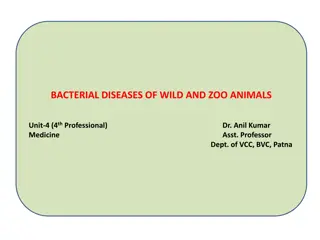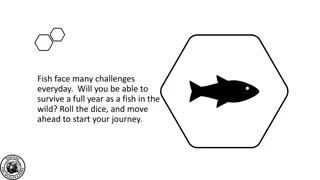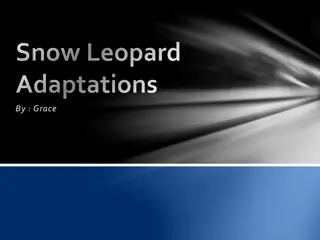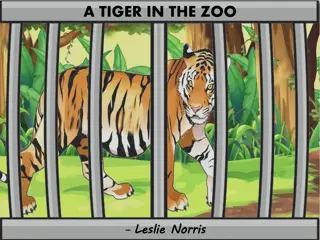
Wildlife Terminology and Conservation Insights
Explore the world of wildlife with terminology defining various aspects of animals, habitats, and ecosystems. Learn about endangered species, food chains, herbivores, predators, migrations, and more. Understand the importance of biodiversity and the significance of native species in their natural habitats.
Download Presentation

Please find below an Image/Link to download the presentation.
The content on the website is provided AS IS for your information and personal use only. It may not be sold, licensed, or shared on other websites without obtaining consent from the author. Download presentation by click this link. If you encounter any issues during the download, it is possible that the publisher has removed the file from their server.
E N D
Presentation Transcript
MESLEK NGLZCE-Ders 4 WILDLIFE TERMINOLOGY Assoc. Prof. zlem B Y KTANIR YA
WILD ANIMALS TERMINOLOGY Wildlife - A broad term that includes non-domesticated animals -mammals, birds, reptiles, and amphibians. Some definitions may include fish and invertebrates. Domesticated A species altered by humans via an evolutionary process with the goal of benefiting humans, though the animals often benefit as well. Ecosystem A dynamic complex of plants, animals, and other organisms, along with their non-living environment, interacting as a functional unit.
Endangered species - A species is endangered when the total number of remaining members may not be sufficient to produce enough offspring to ensure survival of the species. Extinct A species becomes extinct when the last of its kind has died. Endemic species A native species living within a restricted geographic area and not occurring anywhere else. Exotic or Alien or Non-native species A species that occurs in a given region or area as a result of direct or indirect, intentional or accidental, introduction by humans.
Food chain The sequence of plant and animal feeding interactions at different levels within a particular community. Energy is transferred from the lowest level to the highest level (e.g., plants are eaten by insects, which may be eaten by frogs, which may ultimately be consumed by birds).
Habitat - An area that provides a species of animal or plant with adequate food, water, cover, and living space. Herbivore - The category of animals that feed on plants. (herbi-, plant; - vore, eater) Omnivore - The category of animals that feed on both plants and animals. (omni-, all; - vore, eater) Predator An animal that lives by preying on (consuming) other animals. Prey An animal hunted for food by a carnivorous animal.
Migration Movement of animals to and from feeding or reproductive areas, often on an annual or seasonal basis. For instance: Migrating birds Native species Any species of plant or animal that occurs naturally in an area, not introduced by humans.
WILD ANIMALS TERMINOLOGY Biological diversity - The variety of life forms in a given area. Diversity can be categorized in terms of the number of species, the variety in the types of plant and animal species, the genetic variability of the animals, or a combination of these elements. Carnivores - The category of animals that prey or feed upon animals and insects. (carni-, flesh; vore-, eater) Community - A collective term used to describe an assemblage of plants and animals living together.
Carnivores-Lions Lions Lions are carnivorous animals that primarily feed on large herbivores, such as zebras, antelopes, and buffaloes. They are known for their powerful jaws and sharp teeth, which they use to kill and tear apart their prey. Lions are often considered the top predator in their habitat, as they have no natural enemies and are capable of taking down even the largest of herbivores. They are social animals and hunt in groups, using their intelligence and strength to coordinate their attacks and bring down their prey.
Tiger The tiger is a carnivorous animal that primarily feeds on large mammals such as deer, wild boar, and antelopes. It is a skilled hunter that uses its powerful muscles, keen senses, and sharp teeth, and claws to kill and consume its prey. The tiger is also an apex predator in its ecosystem, like the lion, meaning that it has no natural enemies and is at the top of the food chain. It is found in various parts of Asia, including India, Nepal, China, and Russia. Despite its fearsome reputation, the tiger is also an endangered species, with fewer than 4,000 individuals remaining in the wild.
Cheetah The cheetah is a carnivorous animal that belongs to the family Felidae. It is native to Africa and parts of Asia and is known for its incredible speed, making it one of the fastest animals on land. The cheetah feeds on a variety of prey, including antelopes, gazelles, and rabbits. It is a solitary animal and usually hunts during the day. The cheetah has a thin body, long legs, and a distinctively spotted coat that helps it blend in with its surroundings. It is an endangered species, with fewer than 10,000 individuals remaining in the wild.
Wolves Wolves are carnivorous animals. Wolves are known to hunt and eat other animals, including deer, elk, moose, and small mammals like rabbits and rodents. They are skilled predators and often work in packs to bring down their prey. Wolves are found in various parts of the world, including North America, Europe, and Asia. In some areas, they are endangered or threatened due to habitat loss and human conflict. Wikipedia
Anaconda Anacondas are native to South America and are found in countries such as Brazil, Colombia, Ecuador, French Guiana, Guyana, Peru, Suriname, and Venezuela. Anacondas are large, non-venomous snakes that are known for their powerful constricting abilities. They are excellent swimmers and are often found near water sources such as rivers, swamps, and marshes. Anacondas are ambush predators and hunt a variety of prey, including birds, fish, mammals, and reptiles. They are also known to eat large prey, such as deer and capybaras.
Examples of carnivores at sea would include sharks, dolphins, walruses, seals
Great White Shark Fishes are herbivores? The great white shark, also known as the white shark or the white pointer, is a species of large predatory shark found in the coastal surface waters of all the major oceans. It is an example of an aquatic carnivore animal. Great white sharks are carnivores, feeding on a variety of prey including fish, seals, sea lions, and even whales. Great white sharks are feared and respected by many due to their powerful jaws, sharp teeth, and predatory behavior. Despite their reputation, great white sharks are a protected species in many parts of the world and are vital to the balance of ocean ecosystems. Wikipedia Diver with white shark The Guardian






















